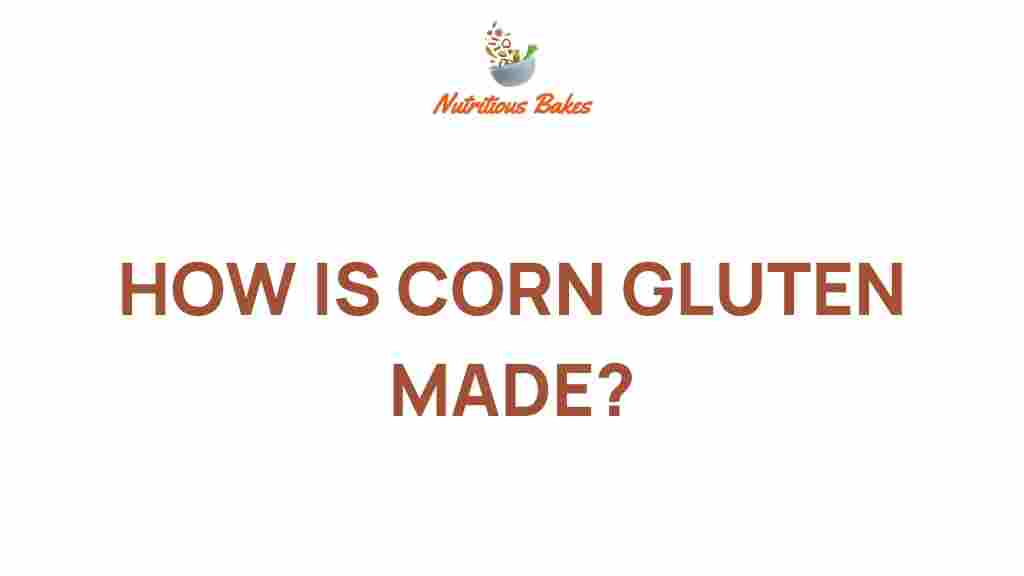Unraveling the Mystery: How Is Corn Gluten Made?
Corn gluten is a fascinating byproduct of the corn processing industry that has gained attention in various fields, including agriculture and the food industry. This article will explore the production process of corn gluten, its applications, and its significance as a sustainable source of nutrition and plant-based proteins. We will also delve into gluten alternatives, making this a comprehensive guide for anyone interested in the multifaceted world of corn gluten.
What is Corn Gluten?
Corn gluten is a byproduct derived from the processing of corn (Zea mays). It is rich in protein, containing around 60-70% protein by weight, and is primarily used as a natural herbicide in agriculture and as a protein supplement in animal feed. The production process of corn gluten involves several steps, transforming raw corn into a valuable ingredient for various applications.
The Production Process of Corn Gluten
The production of corn gluten involves several stages, each crucial to ensuring the quality and nutritional value of the final product. Here is a step-by-step breakdown:
- Step 1: Harvesting Corn
The process begins with the harvesting of mature corn plants. The corn kernels are collected and separated from the cob and husks. - Step 2: Wet Milling
The harvested corn undergoes wet milling, where it is soaked in water and treated with sulfur dioxide. This process helps to separate the starch, protein, oil, and fiber from the corn kernel. The starch is usually the main product, while the corn gluten is a byproduct. - Step 3: Separation of Components
During wet milling, the corn is ground, and the mixture is processed to separate the starch from the protein and fiber. Centrifugation is used to separate the lighter components, and the heavier protein components settle out as corn gluten. - Step 4: Drying
The separated corn gluten is then dried to reduce moisture content. This step is crucial to prevent spoilage and to ensure a longer shelf life. Dried corn gluten is typically in powder form. - Step 5: Packaging and Distribution
Finally, the dried corn gluten is packaged for distribution to various industries, including agriculture as a herbicide and the food industry as a protein source.
Applications of Corn Gluten in the Food Industry
Corn gluten serves multiple purposes in the food industry and beyond. Here are some notable applications:
- Animal Feed: Due to its high protein content, corn gluten is often used as a supplement in animal feeds, providing essential nutrients for livestock.
- Herbicide: In agriculture, corn gluten meal is recognized as a natural herbicide, preventing weed growth without the use of synthetic chemicals.
- Plant-Based Proteins: Corn gluten is an excellent source of plant-based proteins, making it a popular ingredient in vegetarian and vegan products.
- Food Additive: It can be used as a food additive to enhance the texture and nutritional profile of various food products.
Gluten Alternatives: What You Need to Know
In recent years, with the rise of gluten intolerance and celiac disease awareness, many consumers are seeking gluten alternatives. Corn gluten, while not gluten-free, is often considered a viable option for those looking for plant-based proteins without the complexities of wheat gluten.
Here are some alternatives to traditional gluten sources:
- Rice Protein: A popular option for those avoiding gluten, rice protein is easily digestible and hypoallergenic.
- Pea Protein: Derived from yellow split peas, this protein is rich in essential amino acids and is gluten-free.
- Quinoa: This ancient grain is a complete protein and offers a gluten-free alternative.
The Role of Corn Gluten in Sustainability
The production of corn gluten aligns with sustainability goals in several ways:
- Reduction of Waste: As an agricultural byproduct, corn gluten reduces the waste generated from corn processing, allowing for a more efficient use of resources.
- Natural Herbicide: The use of corn gluten meal as a natural herbicide minimizes reliance on synthetic chemicals, promoting environmentally friendly farming practices.
- Plant-Based Protein Source: As the demand for plant-based proteins increases, corn gluten contributes to sustainable nutrition by providing an alternative to animal proteins.
Nutrition Profile of Corn Gluten
Corn gluten is not only a useful agricultural byproduct but also a nutritionally valuable ingredient. Here are some key nutritional aspects:
- High Protein Content: With about 60-70% protein, corn gluten is an excellent source of plant-based protein.
- Amino Acids: It contains essential amino acids that are vital for various bodily functions.
- Low in Carbohydrates: Corn gluten is lower in carbohydrates compared to whole corn, making it a suitable option for specific dietary needs.
Troubleshooting Tips for Using Corn Gluten
When incorporating corn gluten into your diet or agricultural practices, consider the following tips:
- Storage: Store corn gluten in a cool, dry place to maintain its quality and prevent spoilage.
- Application Rate: When using as a herbicide, adhere to recommended application rates to maximize efficacy.
- Check for Allergies: Although corn gluten is a plant-based ingredient, individuals with corn allergies should avoid it.
Conclusion
Corn gluten is a remarkable agricultural byproduct with a diverse range of applications, particularly in the food industry and sustainable agricultural practices. Understanding the production process of corn gluten and its nutritional benefits can help consumers and producers alike make informed decisions. As the demand for plant-based proteins and gluten alternatives continues to grow, corn gluten stands out as a sustainable and nutritious option.
For more information on plant-based proteins and their benefits, explore our related articles. Additionally, to learn about the benefits of various gluten alternatives, check this external resource.
This article is in the category Ingredients and created by NutritiousBakes Team
